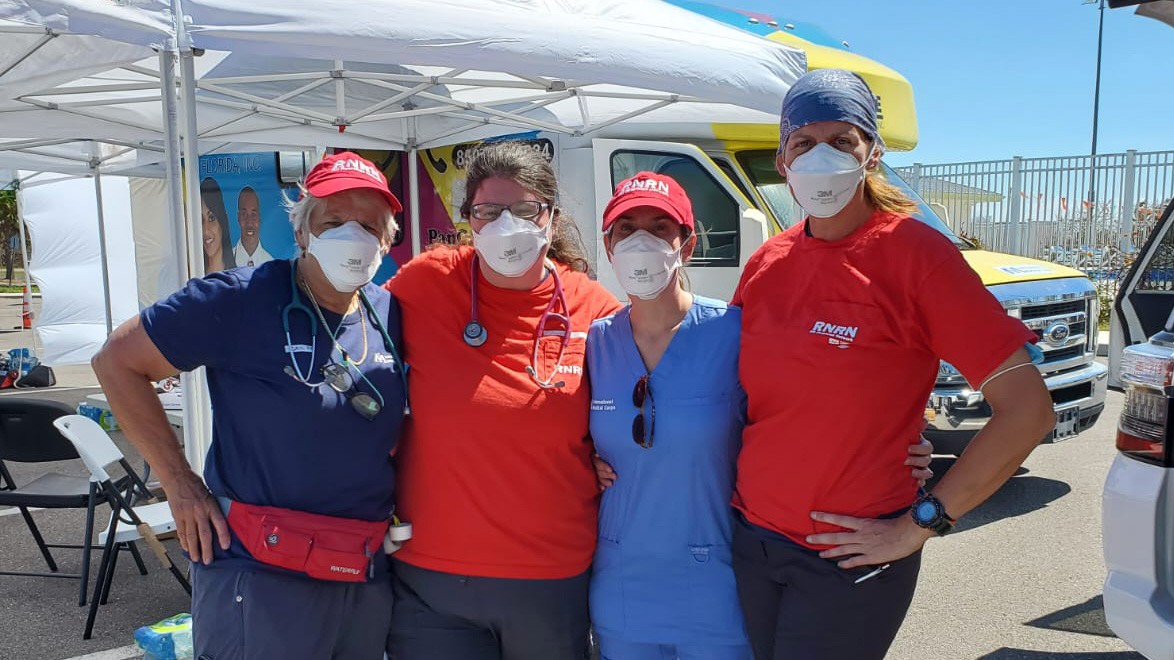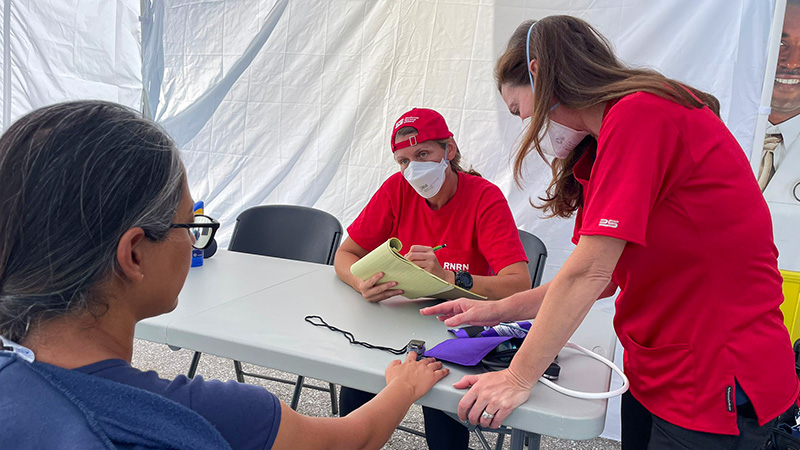Picking Up the Pieces

RNRN volunteers practice basic public health nursing and whatever it takes to help victims of Hurricane Ian
By Chuleenan Svetvilas
National Nurse Magazine - Oct | Nov | Dec 2022 Issue
When Hurricane Ian slammed into the southwest coast of Florida on Sep. 28 as a Category 4 storm, its deadly winds reached 150 miles per hour. More than 4 million Floridians lost power, hospitals in the path of the destructive hurricane were severely damaged, thousands of homes were destroyed, and more than 100 people died.
In the wake of the widespread devastation, nurses from Registered Nurse Response Network (RNRN), a disaster-relief project of California Nurses Foundation and National Nurses United, answered the call to work in partnership with International Medical Corps to help the hurricane survivors in Port Charlotte and Englewood, Fla. One team of four RNRN volunteers flew to Florida on Oct. 3 for a two-week deployment, followed by a second team of three nurses who stayed for six days.
The first team of RNRN nurses began their deployment in Port Charlotte, an unincorporated Gulf Coast community of more than 60,000 people. The power was still out, a boil water notice was in effect, and the weather was sweltering. Temperatures in the high 80s, humidity in the high 90s, and dew points in the 70s made for a very muggy and hot environment. A Tampa TV station’s dew point chart labels a 70- to 74-degree dew point as “oppressive” and over 75 as “miserable.”
“When we arrived, no stores were open or if anything was open, you needed cash,” said Venessa Soldo-Jones, an RN in the ER at Mercy Hospital in Coon Rapids, Minn. and the team lead for the first group of RNRN volunteers. ”You can’t get groceries without cash. There’s no gas in your car, no gas to run a generator, pharmacies are closed, doctors’ offices are closed.”
International Medical Corps, which provided logistics and communications in addition to its own volunteer doctors and nurses, set up a mobile medical unit (MMU) in the parking lot of a Boys & Girls Club in Port Charlotte. The MMU included several canopy tents with different functions: a check-in table, waiting areas, triage, treatment, and patient isolation for anyone with communicable illnesses. If a patient needed privacy, there was a large air-conditioned ambulance with two patient “rooms” where they could be seen by a doctor.
The RNRN volunteers initially split their time between staffing the MMU and canvassing Port Charlotte neighborhoods on foot to spread the word that a medical clinic was open and tarps, water, generators, and other supplies were also available. If people were unable to come to the MMU, the nurses could help get generators delivered or return to treat them. The MMU also provided Covid tests and flu and tetanus shots. As the nurses canvassed, they saw some homes with collapsed roofs and some with minimal damage as well as plenty of debris from felled trees and torn street signs, to stray mattresses and broken mailboxes. They met a man who was living in his car in the driveway because the roof of his house had caved in.
“When we knocked on doors, people apprehensively answered the door,” recalled Soldo-Jones, who has been on several previous RNRN deployments, including Puerto Rico for Hurricane Maria in 2017 and Grand Bahama for Hurricane Dorian in 2019. “Once they found out that we were nurses and doctors, they would throw the door open, come outside and want to talk.”
“Nobody comes to these areas,” said Soldo-Jones. “People would often say, ‘Are you FEMA? You’re the first people who have been here. I thought we were forgotten.’”

The nurses also gave the hurricane survivors information on resources, and things you need to repair your house. They let people know that they could access the internet at Boys & Girls Club, which had a generator. “We were an all-encompassing public health, public safety resource type of team,” said Soldo-Jones. “We were teaching them about mold prevention, how to avoid food-borne diseases, about safety and water. We were providing preventative care and problem-solving.”
“We were doing triage, basic nursing, and wound care,” said Tammi Bachecki, a trauma ICU nurse at Kaiser Permanente Vacaville Medical Center in Vacaville, Calif. “We saw a lot of dangerous cuts and wounds that were infected or on the way to being infected that we were able to prevent from becoming major infections.”
Patients with any serious injuries or critical medical conditions were referred to the local emergency room or one of the Disaster Medical Assistance Teams, known as DMATs, which provide emergency medical care and are part of the Federal Emergency Management Agency (FEMA).
“We had at least two referrals every day to a DMAT or local ER,” said Gail Yost, a retired pediatric RN from California. “That’s where we sent people if they needed an X-ray, had a severe infection, severe swelling, or something we could not treat.”
The RNRN team worked in Port Charlotte for less than a week before the state of Florida asked International Medical Corps to relocate the MMU to Englewood, where the Red Cross had set up a shelter for displaced people in a spacious recreational center. Once there, the nurses’ daily routine began with setting up tents, tables, paperwork, and equipment in the morning and then taking on their assignment for the day: check-in, triage, treatment, or rounding to give breaks or assist wherever needed.
As the RNRN team lead, Soldo-Jones handled the daily logistics of staffing and delegating responsibilities, conducting a recap and debrief at the end of each day with the team, a daily brief with RNRN, and ensuring the team’s health and safety, especially important when the weather conditions were uncomfortably warm and humid. They spent the remainder of their time in Englewood, as did the second team of nurses that arrived on Oct. 17.
“A couple of days it was so hot, we weren’t sweating anymore,” said Bachecki, who also participated in RNRN deployments in the aftermath of Hurricanes Rita (2017), Michael (2018), and Dorian (2019). “Venessa went out and bought electrolyte pills to help us stay hydrated.”
In Englewood, many people staying in the shelter had lost their homes. That’s also where the nurses met people from Port Charlotte, which is 22 miles east of Englewood. Many just needed someone to listen to them. Some were under severe stress because they lost everything. “One woman came to the clinic five days in a row just to talk to someone,” said Yost, who also volunteered for RNRN’s Hurricane Michael deployment. “She would cry and then go back home.”
The nurses saw plenty of cuts and bruises, a broken arm, infections, patients concerned about their blood pressure or worried about their health, and many upper respiratory illnesses due to damp homes or community living situations.
What keeps the nurses coming back is their deep desire to help people. “It gets you back to the heart of nursing, to help people who don’t have other means of assistance,” said Bachecki, who has now volunteered on four of RNRN’s hurricane deployments. “Everything they had in the world is gone. It’s heartbreaking, but it feels good to help someone.”
Bachecki worked for years at a nonunion hospital where if she wanted to do something like RNRN, she had to find people to cover her shift and request vacation. “Now that I work for a union hospital, it is super easy because RNRN is part of our collective bargaining agreement,” said Bachecki. “I just contact my labor rep who emails staff and management and my employer lets me off.”
Chuleenan Svetvilas is a communications specialist at National Nurses United.